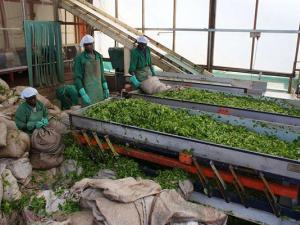
Kenya leads the pack in turning the tide against climate change
As disillusioned Kenyan sugarcane farmers seek other lucrative activities, the Climate Finance Unit in the National Treasury says it is looking for funds to make the crop climate resilient crop.
“This is part of the climate smart agriculture strategy that Kenya has adopted,” said Peter Odhengo, a senior policy analyst of climate finance at the National Treasury.
Kenya is among the first countries to design and implement a climate smart agriculture strategy.
he initial phase of the project involves a $230 million programme focusing on 23 counties in arid and semi-arid lands.
This project is being funded by various development partners, among them the World Bank.
Climate proofing economies was one of the topics at the 24th United Nations Framework Convention on Climate Change in Katowice, Poland.
“We are here to make our voice heard. We want to get the rich countries to commit to increase funding for building resilience in vulnerable countries such as Kenya,” said Mr Odhengo.
“Countries such as Kenya have climate change laws and policies, the only such laws on the whole continent.
“Our job now is how to ensure that we leverage these policies to ensure that the people most affected by the impact of climate change are adequately compensated for their losses,” said Mithika Mwenda, the executive director of the Pan African Climate Justice Alliance.
It is not clear how much money Kenya needs to climate proof its economy, but, according to Mr Odhengo, “it is so much that the government alone cannot finance it.”
“If you look at the National Climate Action Plan 2018-2022, it is trillions of shillings, while the the first climate change assessment report of 1998 quotes Ksh1.5 trillion ($15 billion) over a 10-year period,” said Mr Odhengo.
In 2010, the global fund — Green Climate Fund was set up to help countries such as Kenya go green. In order to manage the money from a fund such as this, Kenya created a Climate Finance Unit in the National Treasury.
“We have started tracking climate finance flows, where it goes, and who handles it while measuring the impact using simple tools such as the number of livestock that can withstand climate shocks and the amount infrastructure that was destroyed by harsh weather,” added Mr Odhengo.
In the past five years, the Green Climate Fund has disbursed more than $500 million to Kenya, some of which came from the World Bank Climate Investment Fund.
Among the projects funded are geothermal power and M-Kopa Solar.
In February, Kenya, through Sessional Paper No. 3 on National Climate Finance Policy, provided guidelines for the use of money intended for climate-proofing of the economy. Kenya is the first country in the world with such a policy.
In July, Mexico and some Caribbean countries reached out to Kenya for help in designing such a policy.
The GCF requires beneficiaries to put in place strict traceability mechanisms that will ensure the money goes where is intended.
“There is what is called a delivery partner. The money doesn’t go directly into the hands of any corrupt individual. This accredited entity is monitored by the national government through the Treasury on a daily basis. They are also monitored by the GCF itself. We code the money, we track it, we report it and we have monthly stakeholder engagement to see where the money has gone.”
Carbon credits
A carbon credit project involving mangroves in Kwale County in Kenya is currently being monitored and evaluated fin the wake of claims that the carbon credits may not have been properly priced.
“Access to climate finance is complex. First, you have to have the technical capacity to develop a bankable project proposal. Once that is done, you present it to Treasury, we look at it to see if it conforms to our climate finance strategy medium term expenditure framework, and the climate change laws in place.
“If it all adds up, we write you a letter of no objection and then you submit to the GCF. The role of the country will now be to follow it up on behalf of the applicant.
“You will find that NGOs tend to do good work in the village level but the sustainability and bankability of those projects in the long run is not sufficient, and so they miss out on the climate financing,” added Mr Odhengo.
Climate finance has always been contentious at the global climate meetings.
Vulnerable countries insist that big economies commit at least $100 million to the Green Climate Fund each year, but those targets have never been fully met.
In 2015, a similar meeting in France came up with what is now known as the Paris Agreement, which called on the world to limit global temperature increases to 1.5°C above pre-industrialisation level.
According to the Global Carbon Project, emissions have continued to rise since 2015 and are projected to continue in 2018, by more than 2 per cent to hit a new record, mainly due to sustained growth in oil and gas use.
This growth in global CO2 emissions puts the goals set out in the Paris Agreement in jeopardy.
According to the intergovernmental Panel on Climate Change to limit warming below 1.5°C, carbon emissions should decline by 50 per cent by 2030 and reach net zero around 2050.
Current country commitments lead to +3°C of warming, well above the Paris Agreement goals.
Global fossil carbon emissions — fossil fuels, industry and cement —grew at over three per cent per year in the 2000s, but growth has slowed since 2010, and from 2014 to 2016 emissions remained relatively flat.
However, the climate pledges currently tabled by countries — Nationally Determined Contributions (NDCs) — are still viewed as not good enough, because they will result in global temperatures rises of between 2.7°C and3.5°C.
Africa says this will be catastrophic for its countries because it will mean more droughts and floods.
Kenya’s climate pledge is an eight-page document that is pegged on the Climate Change Act of 2015, which seeks to cut the country’s emissions by up to 30per cent by 2030.
Kenya hopes to achieve this through reforestation activities and climate proofing the agriculture sector.
